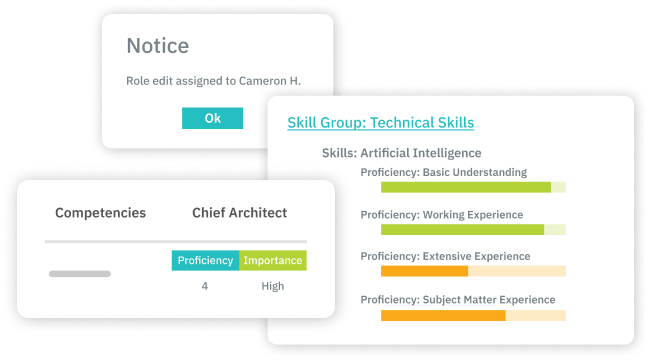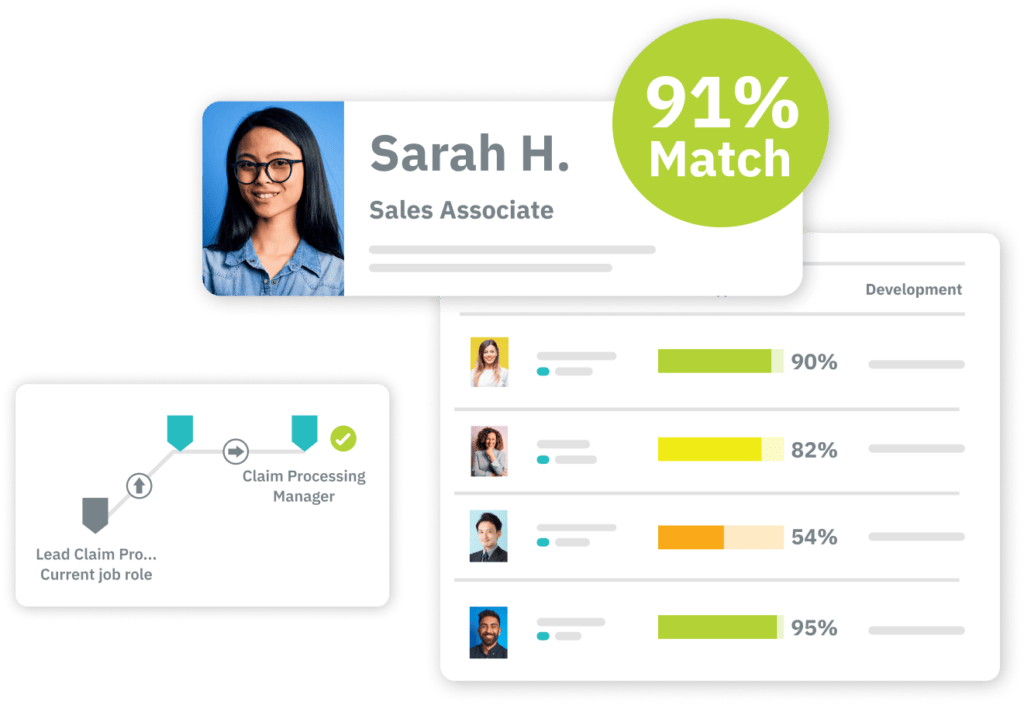The Importance of Proficiency Levels
Why You Need to Compare More Than Skills During Talent Selection
Proficiency levels are crucial in skills and competency management as they help organizations measure, develop, and understand the capabilities of their workforce.

The Importance of Proficiency Levels
An Introduction to Proficiency Levels: Why They Matter for Skills and Competency Management
In any organization, understanding the importance of proficiency levels, skills and knowledge of employees is essential for growth and success. One way to measure these abilities is through proficiency levels. But what are proficiency levels, and why are they important?
Simply put, proficiency levels are stages or categories that indicate how skilled someone is in a specific area. These levels help organizations assess, develop, and understand the capabilities of their workforce. By knowing an employee’s proficiency level, managers can make informed decisions about training, career growth, and even hiring.
Why Are Proficiency Levels Important?
Proficiency provide structure and clarity in understanding the skill levels of employees. Here’s how they benefit both organizations and individuals:
1. Clear Skill Assessment: Proficiency levels give managers a structured way to evaluate employee skills. Instead of guessing whether someone is a beginner or expert, managers can use these levels to identify who has a strong grasp of a skill and who may need further development. This clarity is essential for effective talent management and workforce planning.
2. Targeted Development: Knowing proficiency levels helps organizations target their training efforts. If an employee is at an intermediate level in a particular skill, they can focus on advancing to the next level. This approach ensures that resources are allocated effectively, providing training where it’s most needed.
3. Enhanced Career Pathing: Proficiency levels help employees see a clear path for growth. They understand what it takes to move from one level to the next, empowering them to take control of their own career development.
4. Consistency Across Roles: By applying standardized proficiency levels across similar roles, organizations can ensure consistency in skill requirements. This makes it fairer and clearer for employees and managers alike, as everyone is evaluated on the same criteria.
5. Better Succession Planning: Proficiency levels help identify employees who are ready for higher-level roles. This insight is valuable for succession planning, allowing organizations to prepare individuals for leadership or critical positions.
6. Improved Employee Engagement: When employees know their goals for skill development, they are often more motivated. This can lead to higher job satisfaction and a greater sense of commitment to the organization.
7. Data-Driven Decision-Making: Organizations can use proficiency levels to make strategic decisions about workforce allocation, training investments, and hiring. This approach ensures that teams are equipped to meet current and future business demands.
How Do You Measure Proficiency?
To measure proficiency levels, many organizations use a five-level proficiency scale. This model includes five stages:
1. Fundamental Awareness: Basic knowledge; familiar with the topic but limited in practical experience.
2. Novice: Limited experience; can perform simple tasks with guidance.
3. Intermediate: Practical experience; can work independently on standard tasks.
4. Advanced: Strong skill set; capable of handling complex 2tasks and applying theories.
5. Expert: Full mastery; can teach others and is often a recognized authority in the area.
This scale is useful because it captures the natural progression from beginner to expert, making it easy for both managers and employees to understand skill development paths.
How Can Organizations Use Proficiency Levels?
Organizations often use proficiency measurement software to assess employees’ skill levels. These tools allow managers to view each employee’s qualifications at a glance, making it easier to see who is best suited for specific roles. For employees, these tools provide clarity on where they currently stand and what they need to do to reach the next level.
Previously, assessing proficiency was often based on subjective judgment. Today, HR software offers objective, data-driven evaluations of employee skills, enabling managers to make fair and consistent decisions. This software can also help identify training needs, highlight candidates for promotion, and support employee development.
In summary, proficiency levels are a powerful tool for managing and developing skills within an organization. They provide a clear framework for assessing abilities, setting goals, and creating pathways for growth. For employees, proficiency levels offer a roadmap for career advancement. For organizations, they ensure that the right people are in the right roles, support targeted training, and strengthen succession planning. By investing in proficiency level frameworks and measurement tools, companies can build a skilled, adaptable, and motivated workforce.
Basic
At this stage, employees understand the fundamentals of their position but have little hands-on experience. They can carry out simple tasks as instructed, but still need guidance to build confidence and consistency. Basic proficiency often characterizes individuals starting their careers or transitioning into new areas. By clearly defining proficiency levels at this stage, organizations can set realistic expectations for development and ensure employees have a foundation to build on.
In competency frameworks, basic skill levels act as an anchor for measuring growth. Leaders can use this stage to identify training needs and provide structured learning opportunities. For instance, linking proficiency data to tools like TalentGuard’s Software Skills resource helps HR teams recognize where employees sit on the proficiency level scale and how they can move forward.
Working
The working proficiency level reflects employees who can perform standard tasks independently and reliably. At this stage, employees have the knowledge and confidence to handle daily responsibilities with little supervision. Their practical grasp of job expectations allows them to contribute meaningfully to team performance.
Organizations benefit from clearly defining this stage, as it highlights who is ready for expanded responsibilities. At this point, an employee proficiency level assessment helps managers identify areas for upskilling. Employees at this level often benefit from skills proficiency levels frameworks that guide them toward advanced learning. Career development pathways, such as those explored in Job Families in Talent Frameworks, provide context on how “working” proficiency fits into broader workforce planning.
Extensive
Extensive proficiency reflects years of experience paired with advanced capability. People at this stage can move easily between everyday responsibilities and the unexpected challenges that arise. Because they’ve built confidence in technical and soft skills, they often step into coaching roles, guiding teammates while pushing forward strategic work. Organizations that define and recognize this stage can better prepare for succession planning and leadership pipelines.
When HR teams assess levels of proficiency in job competency, the extensive stage often signals readiness for specialized roles. Employees here typically engage in mentoring, cross-training, or taking on more complex assignments. Leveraging insights from TalentGuard’s Closing the Skills Gap in Business can help leaders connect employee growth at this level to strategic organizational goals, ensuring that the right skills are in place to drive performance.
Expert/Leader
Employees achieve complete mastery of their roles at the expert/leader proficiency level. They are recognized authorities who excel individually and shape the skills and direction of their teams. Experts provide training, establish best practices, and influence organizational strategy. Their leadership ensures consistency across departments, particularly when applying a standardized proficiency level scale.
For organizations, this level is critical for long-term success. Experts are key to succession planning and help transfer knowledge across the business. Understanding what is proficiency level at this stage clarifies what it means to lead, mentor, and innovate. TalentGuard’s The Benefits of Career Pathing shows how defining skills proficiency levels at the leadership stage empowers employees to see a clear roadmap toward executive roles, strengthening engagement and retention.
Take your company to new heights
Whether your company is grappling with talent management for the first time, looking to modernize outdated tools, or searching for that extra competitive edge, our solution can meet you where you are.


Reveal the true nature of your collective talent
TalentGuard’s Workforce Skills Management platform unifies data, software and ecosystem to unlock complete visibility of skills, the intelligence to make data-led talent decisions and the ability to develop the highest potential in your workforce.
See How Our Platform Helps You Build a Future-Ready Workforce
TalentGuard works best with organizations of 500+ employees in the U.S., Europe, Latin America, and regions within six hours of Central U.S.
Every company is at a different stage. Some need to clean up messy job titles and skills first. Others are focused on readiness, mobility, or succession.
Our bundles are built to match those realities. Pick the bundle that’s closest to where you are today, and we’ll tailor the demo to your needs. If you’re unsure whether we serve your region or use case, email info@talentguard.com and we’ll help you find the best fit.
Automate
Create skill profiles, create detailed job descriptions, align learning content with specific skills, and chart clear career path progressions to set the foundation for effective talent management.
Automate includes:
- Create Skill and Competency Profiles
- Develop Job Descriptions
- Map Learning to Skills and Competencies
- Map Career Path Progressions
Assess
Effectively assess their employees’ skills, identify gaps, and implement strategies to develop a skilled and competent workforce prepared to meet current and future challenges.
All the Automate features plus the ability to:
- Create a Skills Inventory
- Conduct Gap Analysis
Engage
Organizations can significantly enhance their talent development strategy and workforce effectiveness by assessing employee skills, curating personalized learning paths, recommending appropriate career paths, and tracking career goals.
All the Automate features plus the ability to:
- Assess Employee Skills and Competencies
- Curate Personalized Employee Learning Paths
- Recommend Employee Career Paths
- Track Career Goals
Optimize
Building talent pools, measuring employee performance, tracking certifications, and conducting multi-rater feedback enhance talent management, ensure compliance, and foster organizational leadership development.
All the Engage features plus the ability to:
- Build Talent Pools
- Measure Employee Performance
- Track Employee Certifications
- Conduct Multi-Rater Leadership Feedback
Your Workforce is Evolving — Be Ready for What’s Next
Read our eBook
Learn more about skills management
Strategic Workforce Planning:
Most companies are sitting on millions in untapped revenue. This talk about how to unlock it using skills intelligence, internal mobility, and financial alignment strategies. The Missed Opportunity Most Leaders Don’t See Your workforce isn’t short on talent—it’s short on visibility. In 2025, Gallup reported that U.S. employers lost $1.9 trillion in productivity due […]
From Order-Taker to Strategy-Maker
A Practical Guide for HR Leaders to Link Talent Decisions to Business Impact The Problem with Being Left Out of the Business Conversation Too often, HR is handed a hiring number with no context—”find 10 underwriters”—as if people were just a plug-and-play resource. There’s no discussion of revenue impact, talent availability, or future readiness. Just […]
Building a Bias-Resistant Skills Assessment Program
HR leaders know the promise of AI in assessments: faster decisions, deeper insights, and reduced bias. But let’s be honest – most platforms don’t tell you how their AI works or how it minimizes bias. You get a black-box score, a dashboard, and maybe a few data points, but not the “why” behind the result. […]




